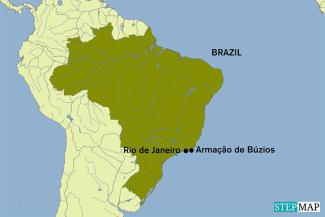History preservation
Reclaiming a legacy

These settlements, known as Quilombos, are nearly extinct today. Almost all their residents have long since died, and most of those residents’ descendants have moved away. But Brazilian authorities now are trying to preserve some of these communities and tell their story – both as a sombre reminder of the evils of slavery and as a new cultural attraction for tourists.
Quilombos were essentially communities of active resistance formed by escaped African slaves, who were first brought to Brazil in the mid-1500s. Quilombos were established over the centuries until slavery was abolished in 1888. At least 10 such settlements were created. Most were small, but some of the more populous ones tried to cooperate with each other to protect their freedom.
Most Quilombos were established in the remote hinterland, but not all of them: Two were located in Armação de Búzios, approximately 175 km east of today’s Rio de Janeiro and a docking point for slave ships from Africa. Many of the slaves were taken onward to the locations north of Armação de Búzios, such as Rasa and Baía Formosa.
One of the few remaining live descendants of members of the Quilombo in Rasa is Dona Cecília Carivaldina de Oliveira, age 104. Although slavery was abolished before she was born, Dona Cecília lived many years in the Rasa Quilombo and heard eyewitness accounts of battles for land. She is still active in preserving the Quilombo culture, retelling the stories and recalling preparations for the annual carnival celebration and religious festivals.
Tourism officials and foundations are taking note of the cultural legacy of the Quilombos, working with local groups to create an ecological/ethnic route that highlights the region’s history.
A Quilombo preservation project in Baía Formosa focuses on reviving African traditions, allowing visitors to dig deeper into the culture of Afro-Brazilian slaves. “The idea is to take the tourists there and say: Look, here we were born, and my parents and great-grandparents too, and we were expelled from that place and now we seek to return there because it is our right,” says Beth Fernandes, president of the Quilombola Association of Baía Formosa.
In Armação de Búzios, meanwhile, volunteers are aiding the construction of a new cultural space, which will include a replica of a Quilombo kitchen creating traditional African recipes. The Quilombo settlements in Armação de Búzios could attract more foreign tourists, who are already coming to the city in large numbers, according to a study by the Tourism Ministry.
While most tourists still come to Armação de Búzios mainly for its beaches, surfing, fine dining and nightlife, they should also give a thought to the people who made the city what it is today, says Rosilene Pereira, the city’s counsellor of culture.
“We only talk about the beaches and the money that circulates here, but then I ask you: what do we say about our people?’’, she says. “We cannot forget how much suffering our people went through so that all this is possible.”
Thuany Rodrigues is a journalist in Brazil.
thuanyrodriigues@gmail.com








